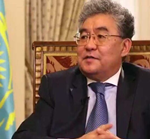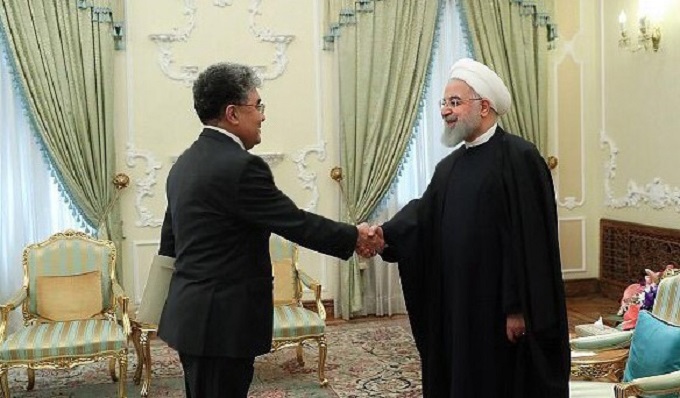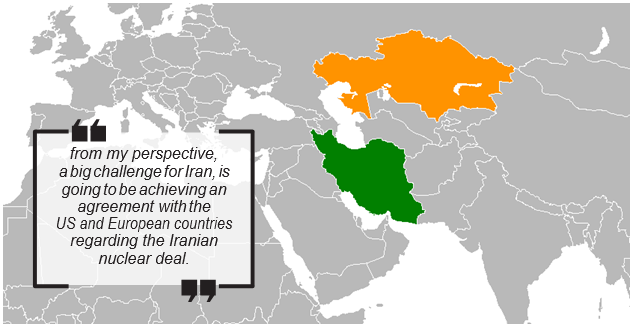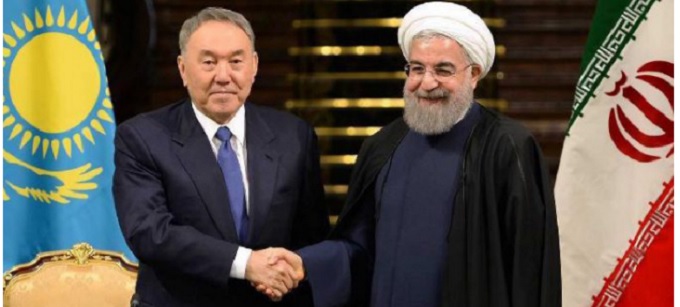By: Embassy of kazakhstan
 Ambassador Orazbay is a Kazakh career diplomat. After joining the Foreign Office of the Republic of Kazakhstan in 1992, he advanced to top diplomatic posts including Secretary General of the Economic Cooperation Organization, ECO, from 2004 to 2006, Kazakhstan’s national representative to the Shanghai Cooperation Organization from 2006 to 2008, Ambassador of Kazakhstan to Turkmenistan from 2008 to 2012, Ambassador of Kazakhstan to Indonesia from 2012 to 2019, and ambassador of Kazakhstan to the Philippines from 2015 to 2019. He currently serves as the Ambassador of Kazakhstan to Iran and is the permanent representative of Kazakhstan to the Economic Cooperation Organization.
Ambassador Orazbay is a Kazakh career diplomat. After joining the Foreign Office of the Republic of Kazakhstan in 1992, he advanced to top diplomatic posts including Secretary General of the Economic Cooperation Organization, ECO, from 2004 to 2006, Kazakhstan’s national representative to the Shanghai Cooperation Organization from 2006 to 2008, Ambassador of Kazakhstan to Turkmenistan from 2008 to 2012, Ambassador of Kazakhstan to Indonesia from 2012 to 2019, and ambassador of Kazakhstan to the Philippines from 2015 to 2019. He currently serves as the Ambassador of Kazakhstan to Iran and is the permanent representative of Kazakhstan to the Economic Cooperation Organization.
Orazbay also served as the political affairs officer of the UN Special Mission for Afghanistan, director of the department for Asia, Middle East and Africa of the Ministry of Foreign Affairs of the Republic of Kazakhstan and Ambassador-at-large of the Kazakh Foreign Office. As a specialist in and with a background in oriental studies, Ambassador Orazbay is fluent in Farsi, English, Russian and Turkish. He holds the highest diplomatic rank – Ambassador Extraordinary and Plenipotentiary and is decorated with many state awards from the Republic of Kazakhstan.
Thank you so much for giving Trends this exclusive interview despite your busy schedule, we are very grateful. If you were to summarize the state of affairs between Iran and Kazakhstan, in terms of political relations as well as trade activities and cultural exchanges, how would you describe it?
Thank you very much for this opportunity to enlighten the readers of such a well-respected magazine, Trends, on the development of Kazakh-Iranian relations. Historically, Iran has always been a very important partner and neighbor to Kazakhstan. I can characterize the current state of our bilateral affairs as well-developing and quite promising in all fields of our bilateral cooperation.
In terms of political relations, since the visit of our first President, President Nursultan Nazarbayev to Iran in November 1992, our countries have never had any troubles or turbulences and have only shown mutual support and a strong political will to strengthen our ties. Both countries have been reciprocating by supporting each other.
We appreciate Iran’s invaluable support of our bid to the UN Security Council, in our hosting of the Expo 2017 and in signing a Statute of Islamic Food Security Organization headquartered in Nur-Sultan, our capital.
Just to demonstrate the great dynamics of political contacts at the highest level, I can mention that in 2019 we had meetings between our Presidents, Kassym-Jomart Tokayev and Hassan Rouhani, and our Prime Minister Askar Mamin and Iranian Vice President Eshaq Jahangiri. Also last year, the Iranian Foreign Minister, Mohammad Javad Zarif, and the First Deputy Speaker of Iranian Parliament, Masoud Pezeshkian, visited our capital and we also had political consultations between our Foreign Ministries in Tehran.
Despite COVID-19, our leaders are in regular contact with each other. In May of this year, our Presidents had a phone call to discuss the state and prospects of development of Kazakh-Iranian relations, including issues of increasing trade and economic cooperation, as well as measures to tackle the Coronavirus.
Before that, our Foreign Ministers also held a phone conversation. Just a few months ago, our Ministers in charge of infrastructure also discussed the development of our transit-transport links by phone. Our countries also successfully cooperate in the framework of regional and international structures including, the UN, OIC, CICA, SCO, ECO and Special Working Group on the Caspian Sea. We witness similar trends in cultural exchanges. For example, Iranian handicraft artisans took part in the Artisans Fair of the Silk Road Countries held within the framework of the Investment and Tourism Forum’s “Turkistan: One Road – One History” hosted in the city of Turkistan on November 4th and 5th last year.
As for our trade cooperation, unfortunately, it does not match the real potential of our countries due to the current circumstances. But the most important thing is that our business circles have a strong mutual interest in establishing trade ties and expanding them further. Last year our capital hosted the 16th meeting of the Joint Commission on Economic Cooperation where all issues related to the field were thoroughly discussed by both sides. We are quite confident that our trade will come back to the pre-sanction level in the near future because Kazakhstan and Iran have a huge untapped potential that will let us expand our cooperation in all areas despite the existing challenges. We hope that our President’s visit to Iran which is planned for next year will open up a new era in the Kazakh-Iranian relations.
Please tell us about Kazakhstan, its history, business, cultural, and tourist attractions, as well as about major events held this year in Kazakhstan?
Kazakhstan is the ninth largest country in the world with a vast territory comprising 2.7 million square kilometers. It is a Eurasian country situated in the heart of Eurasia with 90 percent of its territory lying in Asia, while 10 percent lies in Europe. Our people therefore share both Eastern and Western values. This factor has hugely influenced our people to become very cosmopolitan and tolerant.
Although Kazakhstan’s population is not too big, with just over 18 million people, it is home to over 130 ethnic groups and 18 religions and spiritual traditions. Being a predominantly Muslim country with more than 70 percent of the population identifying as Muslim, Kazakhstan has successfully ensured inter-ethnic and inter-religious harmony. Kazakhstan began its statehood as far back as 1465, when our first forefathers – Janibek Khan and Kerei Khan– founded the Kazakh Khanate on a territory of modern Kazakhstan which existed up until the mid-19th century. In 1991, after the collapse of the Soviet Union, Kazakhstan regained its independence.
Since then, our country has managed to implement massive economic reforms and huge privatization of state assets which turned our economy from a planned to a free market economy. Throughout the period of independence, Kazakhstan has ensured political stability and managed to resolve all territorial disputes with its neighboring countries by setting down boundary delimitations, including with Russia and China. Now, we enjoy friendly and reliable relations with all of our neighbors. Over the many years of its independence, Kazakhstan has made a huge breakthrough in its socio-economic development and now is among the fastest growing economies with a high GDP growth.
 Today, Kazakhstan is the largest economy in Central Asia with a GDP of 160 billion USD. In fact, Kazakhstan has a higher GDP than all of the other Central Asian states combined.
Today, Kazakhstan is the largest economy in Central Asia with a GDP of 160 billion USD. In fact, Kazakhstan has a higher GDP than all of the other Central Asian states combined.
In regards to the business, cultural and tourist attractions of our country, I would suggest visiting our capital, Nur- Sultan, previously known as Astana. The city was built in record-breaking time from scratch despite all the difficulties of the transitional period.
In less than 10 years, we have managed to build an absolutely new and modern capital. It was designed by prominent foreign architects including the Japanese architect, Kisho Kurokawa, known for designing the Van Gogh Museum in Amsterdam, Kuala-Lumpur International Airport and National Ethnological Museum in Osaka, as well as the British architect, Norman Foster, known as a master of high-tech architecture, with works including the Millennium Bridge in London, the world’s biggest airport in Beijing and the restructured Bundestag in Berlin. So, anyone can easily find many attractions catered to their tastes in Nur-Sultan. Another must-see destination in Kazakhstan is the city of Almaty.
The natural diversity of Almaty is amazing – from scenic canyons to lush valleys, snow-capped mountains, beautiful glaciers and turquoise lakes. Almaty is also a surprisingly modern city. It’s the scientific, cultural, historical, industrial and financial center of the country. So, besides its natural scenery, there is a plethora of attractions anyone can visit and enjoy.
Of course, Kazakhstan can provide many other various attractions for different types of visitors, even for the most indulged ones. To mention a few, there is the ancient city of Turkistan with its famous landmarks like Khoja Ahmed Yassawi, Aisha Bibi and Arystan Bab Mausoleums. There is also one of the oldest cities of Taraz, national reserves of Eastern Kazakhstan and the Caspian Sea in the west. This year marks the 1150th anniversary of the outstanding thinker, translator and composer of the East Abu Nasr Al- Farabi and the 175th anniversary of a Kazakh poet, a great scientist, encyclopedist, composer and philosopher Abai Qunanbaiuly. Their works embody eternity, wisdom, love and faithfulness. Although they lived in different centuries, the deep philosophical treaties and poetic works of Al- Farabi and Qunanbaiuly played a huge role in the writing of the history of oriental civilization and in particular the Kazakh one. Both of these great personalities have close links to Iran. It is believed that Al-Farabi after having left a city of Otyrar in south Kazakhstan traveled to Iranian cities of Nishapur, Rey and Hamedan while Abai’s poems glorify Iranian poets and call them his teachers.
Please tell us about the history of trade between the two countries. Also, what is the trade volume between Iran and Kazakhstan today?
What products and services are being exchanged? When it comes to trade, do you see any major emerging trends or patterns, for example,
the expansion of trade beyond activities in traditional sectors such agricultural commodities?
As I mentioned earlier, the current trade level between our countries does not match their potential. From 2006 to 2007, the trade turnover between Kazakhstan and Iran used to be around 2 billion USD, while in 2009 to 2010 it decreased to 1 billion USD. In 2018, this level declined to 516 million USD, whereas last year our trade shrunk to
380.3 million USD.
The reason for that is the restrictions imposed on Iran.
In the first quarter of 2020, the trade volume between Kazakhstan and Iran exceeded 100 million USD. Traditionally, we export barley, vegetables, lamb and goat meat, animal feed and wheat to Iran, whereas we import from your country fruits and vegetables, dates and nuts, cement, various plastic goods and much more.
It is worthy to note that besides our traditional commodities, such as barley and wheat, there is a growing trend of export of metal and aluminum scraps from Kazakhstan as well as export of fruits and vegetables along with different types of dates from Iran.
We assume that this positive trend is taking place thanks to the temporary agreement on establishment of the Free Trade Zone between Iran and Eurasian Economic Union. So, we hope that this good start will expand to the other commodities of our countries.
Is the Eurasian Economic Union (EAEU) expected to boost trade between the two countries? What would be the potential if the sanctions are lifted?
Of course, the main purpose of signing the temporary agreement on the formation of a free trade zone between EEU and Iran was exactly boosting trade between your country and EEU member-states through the reduction in import duties and establishment of a transparent trade environment. The agreement, operational since October 27, 2019, has provided Iran with special customs privileges from the Eurasian Economic Union and the Union’s member-states from Iran. These privileges include 502 items in the field of food, chemicals, construction products, export of technical and engineering services, industrial products and agricultural products by the Eurasian Union, and 360 items in the same categories by Iran, which amount to a total of 862 items covered by the agreement.
The benefits of Iran joining the Eurasian Economic Union include the creation of a bridge linking the market with more than 180 million people and a potential market to boost exports. Although there are currently only five countries as members of the union, four countries including Iran, Vietnam, Singapore and Serbia have signed Agreements on Establishment of the Free Trade Zones.
Besides that, more than 40 countries and international organizations such as China, Japan, Indonesia, South Korea, India, Hungary, Pakistan, Egypt and even some Latin American countries are ready to work within the union.
The agreement is expected to lead to a major jump in Iran’s exports and can play an important role in Iran’s crossing of economic bottlenecks. So, according to mass media, Iran’s trade with EEU has already surpassed 2.4 billion USD. Certainly, we are also quite optimistic about the trade between Iran and Kazakhstan in light of that trade agreement.
As to the potential in case of lifting the sanctions, we expect a significant jump in trade which should at least reach the level we had before sanctions. As it was said above, in 2006 to 2007 the trade turnover between Kazakhstan and Iran was around 2 billion USD, but this is not the limit of our potential.
What do you see as the biggest hurdles in the way of doing business between the two countries?
Of course, the biggest challenge for business between our countries is the current situation with Iran’s sanctions. It entails many restrictions and risks that discourage businesses from any activities. The main one is the absence of bank transactions after Iran was cut from the international SWIFT system.
But despite that, there are many entrepreneurs interested in establishing or expanding Kazakh-Iranian business links. The lack of information among our business people serves as another hurdle in developing our trade/economic ties. In order to overcome it, our embassy and I participate in various business events, round tables, fairs and conferences as well as hold meetings with Iranian business people.
For instance, last year on the premises of our embassy we held over 50 meetings, I visited more than 10 Iranian provinces where meetings with regional authorities and business circles were held. We held two round tables together with Iranian Chamber of Commerce and one round table with Iranian Chamber of Cooperatives, a Kazakh-Iranian Investment Forum with Golestan Province. In December 2019 in conjunction with the Iranian Chamber of Commerce we held the “Day of Kazakhstan’s Economy” event. The prime focus of these events was providing information about Kazakhstan’s trade/economic and investment opportunities.
This year, despite COVID-19, we try to provide all necessary information to Iranian businesses during our online and
virtual meetings. As you see we do indeed a lot to increase awareness and knowledge of Iranian businesses and I believe the Iranian embassy in Kazakhstan also works hard in that direction. Besides mining and agriculture, what other sectors is Kazakhstan strong in? What sectors can foreign (including Iranian) investors invest in? What is the process for any such investments?
Of course, mining and agriculture are two of the main sectors of Kazakhstan. But from the outset of our independence, the government has been always working hard to diversify our economy. Our National Investment Strategy for 2018-2022 clearly identifies priority sectors for foreign investments. These industries can be divided into two groups. Firstly, there are “industries with the active potential” – the food industry, deep processing of oil, gas and minerals (metallurgy, chemistry and petrochemistry), as well as engineering. The second group is “promising sectors” such as ICT, tourism and finance.
The first group implies such industries in which it is possible to promote foreign direct investments aimed at improving efficiency in the short or medium term. The second group consists of industries in which investors may be interested in the long term. Therefore, our Iranian friends can invest in any of those fields. For these purposes, we have 13 special economic zones and 24 industrial zones with different sectoral orientation and different preferences. They offer investors a zero percent rate for corporate income tax, land tax, property tax, as well as exemptions from customs duties.
Kazakhstan carries out a campaign on privatizing the largest state-owned mining and metallurgical companies, oil and gas, energy, transport and communications, and infrastructure enterprises. Kazakhstan also has a large number of projects in exploitation and development of production of copper, gold, rare and rare-earth metals, including lithium and vanadium, phosphate raw materials and much more. Likewise, we are interested in investing in geological exploration, new technologies for enrichment and processing of raw materials.
We have begun a large-scale modernization of the agroindustry complex. Structural reform and diversification of the agricultural sector is underway. The scientific, technical and technological re-equipment of the entire industry has begun. All this provides great opportunities for investments in the food industry. As it has been mentioned above a new direction for our economy is the development of tourism. For this purpose, a specialized company “Kazakh Tourism” has been created which provides special conditions for companies interested in the development of tourism infrastructure.
The process for any such investments is very easy. Any investor can reach our embassy in Tehran. We will connect them with our “Kazakh Invest” National Company which was established to build effective interaction with investors on the principle of a “one-stop shop.” Kazakh Invest representatives, who are experts in all key sectors, can go through each of these sectors and projects with investors in detail. As a single point of contact and one- stop shop, Kazakh Invest offers investors all the support they need to conduct business in Kazakhstan – from the idea stage all the way through to the implementation. We connect investors with relevant organizations, so that they can easily identify high-quality opportunities for investment and offer necessary administrative support.
What do you see as the opportunities and challenges for Iran in 2020 and beyond?
This year is indeed a very difficult year for all of us. The coronavirus has severely struck our economies. Therefore, the biggest challenge not only for Iran but for all of us is going to be the post-pandemic recovery. But given the strength of the Iranian people and Iran’s economic potential, I firmly believe that Iran can overcome this crisis. Another big challenge for Iran, from my perspective, is going to be achieving an agreement with the US and European countries regarding the Iranian nuclear deal. If it happens, the sanctions could be eased which will positively affect our trade. However, other external and internal challenges would hinder Iran’s development.
Are there any business delegations visiting either side these days? If so, in what sector(s) and when? Are there any major cultural, artistic or sports activities between the two countries planned for 2020 and 2021?
Due to the COVID-19 outbreak, unfortunately, we had to cancel or postpone most of our business activities. For example, four Iranian companies had planned to visit Kazakhstan in the first quarter of 2020 to discuss
particular investment projects with our counterparts in infrastructure, agriculture, logistics and other fields. We were also planning to organize a trade mission led by the Vice Minister of Trade and Integration of the Republic of Kazakhstan and accompanied by Kazakh exporters and importers.
We managed to arrange a visit with the leadership of “Aktau Seaport” Free Economic Zone on February 18, 2020. That visit was very successful and productive because the delegates met the leadership of Qazvin Chamber of Commerce and agreed to implement a joint project in Aktau inbuilding an Industrial-Commercial Complex on the territory of the Special Economic Zone “Sea Port Aktau” with a total amount of investment of about 15 million EUR which will facilitate exporting Iranian goods to Kazakhstan and Central Asia and vice- versa.
The complex will be located on a five hectares area on the Kazakh part of the Caspian Sea. So, we do hope that COVID-19 will be over very soon and we can resume our exchanges with business delegations.
As I have mentioned earlier, during a phone conversation of our presidents this year, Hassan Rouhani, Iran’s President invited our President Kassym-Jomart Tokayev to visit Tehran. That is why, we hope that our President could visit Iran’s capital sometime next year if the situation with COVID-19 normalizes. And generally, plenty of cultural or artistic and business events are held on the sidelines of such high rank visits.
Can we expect further improvement of relations between Iran and Kazakhstan in the foreseeable future, given the challenges including the political climate in the US, sanctions, etc.?
Kazakhstan and Iran have been historically enjoying very friendly and mutually beneficial relations. For sure, things like sanctions and geopolitics always negatively affect the dynamics of bilateral cooperation. In the case of Kazakh- Iranian relations, the impact is very much felt especially in our trade. We should always see the future with full optimism. We therefore believe that the current situation and sanctions will not last forever. So, one day our trade/ economic cooperation will return back to normal and will become a starting point for increasing our bilateral trade. In the meantime, we have many fields excluded from those listed in sanctions that we will explore and develop during these not-so-easy times.





